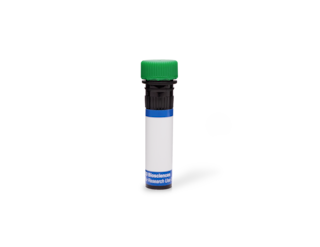-
Reagents
- Flow Cytometry Reagents
-
Western Blotting and Molecular Reagents
- Immunoassay Reagents
-
Single-Cell Multiomics Reagents
- BD® OMICS-Guard Sample Preservation Buffer
- BD® AbSeq Assay
- BD® Single-Cell Multiplexing Kit
- BD Rhapsody™ ATAC-Seq Assays
- BD Rhapsody™ Whole Transcriptome Analysis (WTA) Amplification Kit
- BD Rhapsody™ TCR/BCR Next Multiomic Assays
- BD Rhapsody™ Targeted mRNA Kits
- BD Rhapsody™ Accessory Kits
- BD® OMICS-One Protein Panels
- BD OMICS-One™ WTA Next Assay
-
Functional Assays
-
Microscopy and Imaging Reagents
-
Cell Preparation and Separation Reagents
Old Browser
This page has been recently translated and is available in French now.
Looks like you're visiting us from {countryName}.
Would you like to stay on the current location site or be switched to your location?
BD Transduction Laboratories™ Purified Mouse Anti-SNAP-25
Clone 20/SNAP-25 (RUO)





Western blot analysis of SNAP-25 on a rat cerebrum lysate. Lane 1: 1:1000, lane 2: 1:2000, lane 3: 1:4000 dilution of the mouse anti-SNAP-25 antibody.

Immunofluorescence staining of PC12 cells (Rat neuroblastoma; ATCC CRL-1721).




Regulatory Status Legend
Any use of products other than the permitted use without the express written authorization of Becton, Dickinson and Company is strictly prohibited.
Preparation And Storage
Recommended Assay Procedures
Western blot: Please refer to http://www.bdbiosciences.com/pharmingen/protocols/Western_Blotting.shtml
Product Notices
- Since applications vary, each investigator should titrate the reagent to obtain optimal results.
- Please refer to www.bdbiosciences.com/us/s/resources for technical protocols.
- Source of all serum proteins is from USDA inspected abattoirs located in the United States.
- Caution: Sodium azide yields highly toxic hydrazoic acid under acidic conditions. Dilute azide compounds in running water before discarding to avoid accumulation of potentially explosive deposits in plumbing.
Companion Products


Release of neurotransmitters from neurons is regulated by exocytosis of synaptic vesicles. This exocytosis is mediated by a complex consisting of membrane components of both the synaptic vesicle and the synaptic plasma membrane. The fusion complex consists of the soluble NSF (N-ethyl-maleimide-sensitive factor) and SNAPs (soluble NSF attachment proteins), along with the receptor proteins (known as SNAREs) synaptobrevin, synaptotagmin, syntaxin, and SNAP-25 (synaptosomal-associated protein of 25 kDa- the name is coincidental to the previously mentioned "SNAP" terminology). SNAP-25 and syntaxin are plasmalemmal proteins (designated as t-SNAREs) while synaptobrevin and synaptotagmin are vesicular proteins (designated as v-SNAREs). These four proteins are thought to constitute an initial SNARE docking complex for regulated exocytosis. SNAP-25 lacks a transmembrane domain, but is linked to the membrane by palmitoylated cysteine residues in the central region of the molecule.
This antibody is routinely tested by western blot analysis. Other applications were tested at BD Biosciences Pharmingen during antibody development only or reported in the literature.
Development References (5)
-
Chapman ER, An S, Barton N, Jahn R. SNAP-25, a t-SNARE which binds to both syntaxin and synaptobrevin via domains that may form coiled coils. J Biol Chem. 1994; 269(44):27427-27432. (Biology). View Reference
-
Hasegawa H, Zinsser S, Rhee Y, Vik-Mo EO, Davanger S, Hay JC. Mammalian ykt6 is a neuronal SNARE targeted to a specialized compartment by its profilin-like amino terminal domain. Mol Biol Cell. 2003; 14(2):698-720. (Biology). View Reference
-
Martinez-Arca S, Alberts P, Zahraoui A, Louvard D, Galli T. Role of tetanus neurotoxin insensitive vesicle-associated membrane protein (TI-VAMP) in vesicular transport mediating neurite outgrowth. J Cell Biol. 2000; 149(4):889-900. (Biology: Immunofluorescence, Immunoprecipitation, Western blot). View Reference
-
Oyler GA, Higgins GA, Hart RA. The identification of a novel synaptosomal-associated protein, SNAP-25, differentially expressed by neuronal subpopulations. J Cell Biol. 1989; 109(6 Pt 1):3039-3052. (Biology). View Reference
-
Torii S, Zhao S, Yi Z, Takeuchi T, Izumi T. Granuphilin modulates the exocytosis of secretory granules through interaction with syntaxin 1a. Mol Cell Biol. 2002; 22(15):5518-5526. (Biology: Western blot). View Reference
Please refer to Support Documents for Quality Certificates
Global - Refer to manufacturer's instructions for use and related User Manuals and Technical data sheets before using this products as described
Comparisons, where applicable, are made against older BD Technology, manual methods or are general performance claims. Comparisons are not made against non-BD technologies, unless otherwise noted.
For Research Use Only. Not for use in diagnostic or therapeutic procedures.